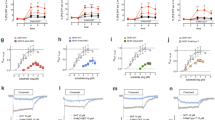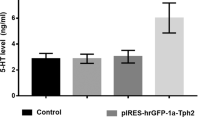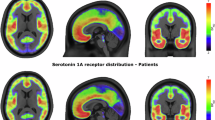Abstract
The rate of serotonin (5-HT) synthesis was measured in the discrete regions of the rat brain utilizing an autoradiographic method and α[14C] methyl-L-tryptophan as a tracer after an acute treatment with reserpine (10 mg/kg IP) or NSD-1015 (m-hydroxybenzylhydrazine) (100 mg/kg IP). Controls were injected with the same volume of solvent in place of reserpine or NSD-1015. Our results showed that reserpine induced a statistically significant (except for medial geniculate body) decrease in the rate of 5-HT synthesis in a large number of discrete brain structures. Reserpine had no influence on the plasma concentration of amino acids sharing the same carrier with tryptophan nor on the fraction of plasma-free tryptophan. NSD-1015 induced a statistically significant increase (p <. 05) in the rate of 5-HT synthesis in 20 out of 28 brain regions but produced a pronounced decrease in the rate of 5-HT synthesis in the pineal body. This decrease in the pineal body serotonin synthesis rate is most likely the result of the loss of the label in the form of 5-hydroxy-α[14C]methyl-L-tryptophan [5-OHMTrp] that is not metabolized further because aromatic amino acid decarboxylase was inhibited. The data showing that there was no loss of the 5-OHMTrp from other brain structures as result of reserpine are also given. NSD-1015 treatment also induced a time-dependent increase in the plasma concentration of free tryptophan that becomes significant 30 minutes after NSD-1015 injection. Our results suggest that reserpine induces a decrease in 5-HT synthesis probably via direct or indirect inhibition of tryptophan hydroxylase activity. Since NSD-1015 alone increased the rate of 5-HT synthesis, the measurement of 5-HT synthesis in previous experiments using NSD-1015 and measuring the rate of 5-hydroxytryptophan accumulation after NSD-1015 induced inhibition of decarboxylase activity should be interpreted with reservation.
Similar content being viewed by others
Log in or create a free account to read this content
Gain free access to this article, as well as selected content from this journal and more on nature.com
or
Author information
Authors and Affiliations
Additional information
Results were in part presented at the Twenty-Third Annual Meeting on Neuroscience Society in Washington, DC, November 7-12.
Rights and permissions
About this article
Cite this article
Mück-Šeler, D., Diksic, M. The Acute Effects of Reserpine and NSD-1015 on the Brain Serotonin Synthesis Rate Measured by an Autoradiographic Method. Neuropsychopharmacol 12, 251–262 (1995). https://doi.org/10.1016/0893-133X(94)00084-D
Received:
Revised:
Accepted:
Published:
Issue date:
DOI: https://doi.org/10.1016/0893-133X(94)00084-D
Keywords
This article is cited by
-
Functional constituents of a local serotonergic system, intrinsic to the human coronary artery smooth muscle cells
Molecular Biology Reports (2015)
-
Measuring serotonin synthesis: from conventional methods to PET tracers and their (pre)clinical implications
European Journal of Nuclear Medicine and Molecular Imaging (2011)
-
Increased dopaminergic and 5-hydroxytryptaminergic activities in male rat brain following long-term treatment with anabolic androgenic steroids
British Journal of Pharmacology (1999)
-
α-Methyl-l-tryptophan as a tracer to study brain serotonergic system
Neurochemical Research (1995)



